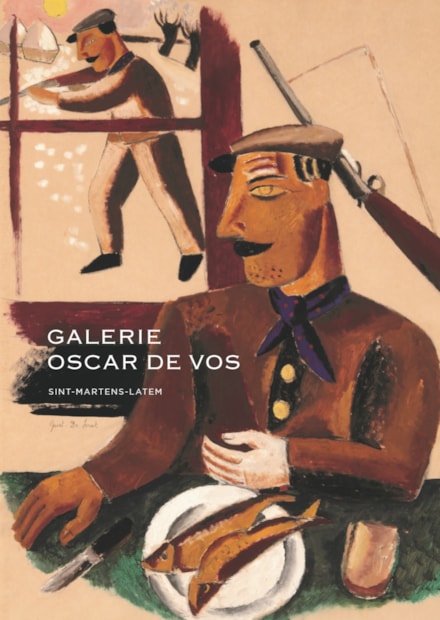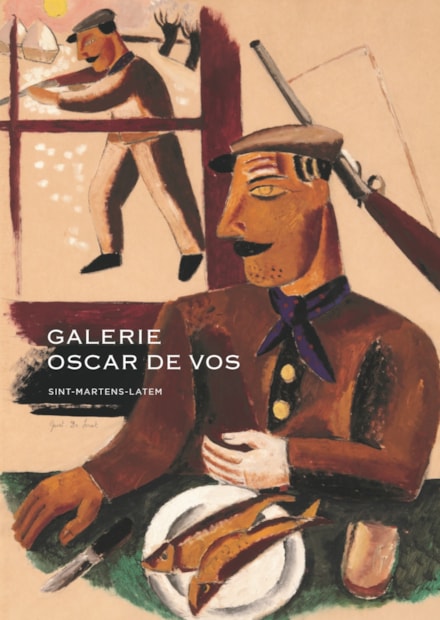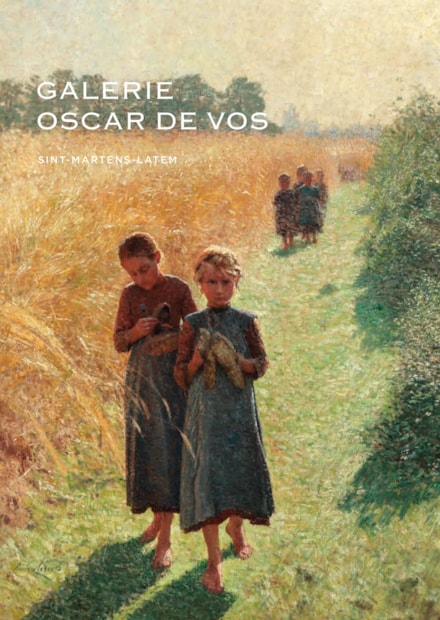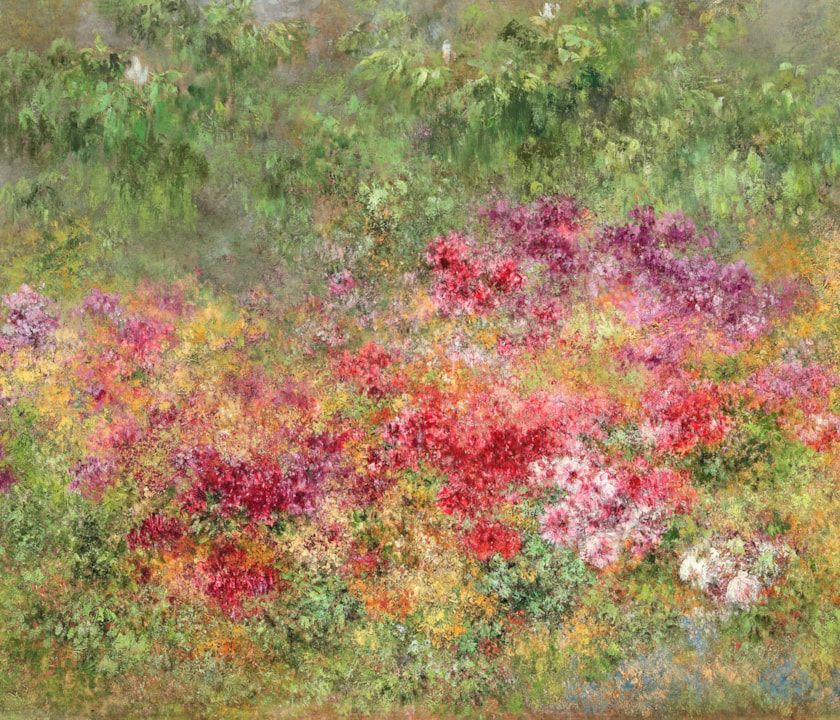Albert Saverys
(1886 - 1964)

Albert Saverys
(1886 - 1964)
Né à Deinze d’un père peintre décorateur, Albert Saverys suit dans un premier temps des cours à l’École de Dessin de la Ville. Après la mort subite de son père en 1902, la charge de sa famille pèse sur ses jeunes épaules; le jeune homme n’a donc plus beaucoup de temps pour étudier. Les cours de jour sont exclus. Les cours du soir à l’École Nicaise de Gand doivent lui permettre de réussir dans les arts décoratifs; il y apprend à représenter le marbre et le bois. Pendant toute sa carrière, il restera d’ailleurs passionné par les arts appliqués. Artiste peintre confirmé, il conseillera par exemple les Ateliers d’Arts de Courtrai De Coene, pour qui il créera, entre autres, des paravents dans le style japonisant et Art Nouveau.
Ses années à l’Académie des Beaux-Arts de Gand à partir de 1912 sont d’une plus grande importance pour le développement de sa carrière d’artiste peintre. Il y connaît les dernières années de Jean Delvin, professeur et directeur de l’institution et qui a enseigné à tant de protagonistes de Laethem. Parmi ses condisciples, on trouve, entre autres, Albert Claeys et Evarist De Buck. Entre-temps, il participe à des expositions. Il acquiert assez vite la notoriété, d’abord sur le plan local et à partir de 1913 au niveau national. La Société Royale des Beaux-Arts, organisatrice, lui achète l’une de ses œuvres lors de la première exposition importante à laquelle il participe, l’Exposition Mondiale de Gand. Juste avant la guerre, il est également remarqué à la Salle Taets de Gand. En juillet, il est encore, entre autres avec Robert Aerens, De Buck et Claeys, l’hôte de l’Hôtel Royal sur le Kouter à Gand. Il y voit immédiatement l’opportunité d’une association d’artistes. Depuis sa création en mai 1914, Saverys sera l’un des premiers membres à faire partie de “l’Algemeen Kunstverbond” pour les Flandres orientale et occidentale.
La guerre donne un coup d’arrêt à ses débuts et, comme lui, ses contemporains Claeys et De Buck sont gênés dans leur évolution. Les chances d’exposer sont moindres. Mais au niveau local de Gand, différentes associations restent actives, comme le Kunstverbond cité plus haut, le cercle Kunst en Kennis et l’association des anciens élèves de l’Académie de Gand. En 1916, il a la chance de rassembler un plus grand ensemble lorsque, avec Anna De Weert et Achiel Vereecken, il peut remplir les cimaises de la Salle Taets. Un an plus tard, il expose de nouveau à la galerie gantoise; il ne doit plus compter alors qu’avec la présence à ses côtés du sculpteur Leon Sartel. En mars 1920 suit une importante étape avec son exposition individuelle chez Taets; le triomphe vient un an plus tard avec l’exposition retentissante à la galerie bruxelloise Le Centaure, qui est à ce moment avec Sélection le foyer de l’avant-garde de la capitale. L’exposition connaît un énorme succès et, à la fin, la galerie peut fièrement afficher: “tout est vendu!”
En peu de temps et sur un tempo très rapide, Saverys se retrouve au sommet de l’art belge. Les expositions individuelles se succèdent. Il est également remarqué sur le plan international; entre les deux guerres mondiales, il est invité pas moins de six fois à la Biennale de Venise. Il est présent dans pratiquement toutes les expositions d’ensemble d’art belge organisées pendant toutes ces années à l’étranger. Il est également invité à maintes reprises aux prestigieuses expositions annuelles du Carnegie Institute de Pittsburgh.
Le succès lui permet de faire construire en 1922-1923 une vaste demeure-atelier à la Gentsesteenweg, entre Deinze et Petegem. Saverys baptise sa maison “Ter Kauwkesh”. Pour architecte, il engage August De Smet, qui avait auparavant dessiné pour Servaes la ‘Torenhuis’ à Laethem-Saint-Martin et construit ensuite la maison de De Smet à Deurle.
Entre-temps, Saverys reste à l’avant-scène de Bruxelles. La célèbre galerie Georges Giroux l’engage dans l’entre-deux-guerres pour de nombreuses expositions. A la fin des années 1920, l’artiste est devenu une grande figure mondaine qui étend ses relations jusqu’à la famille royale de Belgique.
Les années de crise semblent révolues pour l’artiste. Ses expositions chez Giroux restent un événement mondain. En 1937, il obtient une exposition dans le centre d’art de la ville par excellence, le Palais des Beaux-Arts de Bruxelles. La même année suit encore une reconnaissance officielle. Il est nommé professeur à l’Institut National Supérieur des Beaux-Arts d’Anvers. Jusqu’à l’âge de la pension, il restera professeur dans la cité scaldienne.
Saverys passe les années de guerre de manière relativement insouciante. Il expose régulièrement à Anvers et Bruxelles: jusqu’en 1949, il néglige quelque peu Gand.
Saverys débute dans la tradition du luminisme, mais ce n’est certainement pas un disciple servile d’Emile Claus. L’artiste se sent plutôt attiré par la technique du divisionnisme, dans laquelle dominent le linéaire et un lourd coup de pinceau. Dans l’essence, il est à ce moment plus proche de Vincent van Gogh et du fauvisme français de, par exemple, Maurice de Vlaminck. Pendant les années de guerre, il porte une attention curieusement importante au dessin et à l’art graphique, avec des lithographies et des eaux-fortes aujourd’hui un peu oubliées. Dans ses paysages, il étudie de préférence des arbres imposants: peuplier et saules têtards dominent le plan de l’image.
Après l’Armistice, il passe par une courte période expressionniste. Petit à petit, il va plus synthétiser, et la technique divisionniste va disparaître. Son coloris devient sombre et lourd, le coup de pinceau plus large et plus robuste. La Lys à Deinze et son environnement immédiat suscitent son intérêt. Avec son ami Modest Huys, il a une prédilection pour de simples tableaux de kermesse, entre autres, la Machelen-Gilde.
Le tempérament de Saverys se situe diamétralement à l’opposé du calcul de l’expressionnisme. Son audace et sa technique ne peuvent se laisser brider. Son art est plus lyrique, plus en phase avec le paysage lui-même. Dans son essence, Saverys est entre les deux guerres mondiales le paysagiste le plus marquant de la région de la Lys. La Lys est son sujet favori, un thème qu’il sait à chaque fois redécouvrir. Il est magistral dans ses coloris, dans la richesse des contrastes, dans les vues panoramiques rapidement brossées de la Lys entre Deinze et Laethem-Saint-Martin.
Ses années à l’Académie des Beaux-Arts de Gand à partir de 1912 sont d’une plus grande importance pour le développement de sa carrière d’artiste peintre. Il y connaît les dernières années de Jean Delvin, professeur et directeur de l’institution et qui a enseigné à tant de protagonistes de Laethem. Parmi ses condisciples, on trouve, entre autres, Albert Claeys et Evarist De Buck. Entre-temps, il participe à des expositions. Il acquiert assez vite la notoriété, d’abord sur le plan local et à partir de 1913 au niveau national. La Société Royale des Beaux-Arts, organisatrice, lui achète l’une de ses œuvres lors de la première exposition importante à laquelle il participe, l’Exposition Mondiale de Gand. Juste avant la guerre, il est également remarqué à la Salle Taets de Gand. En juillet, il est encore, entre autres avec Robert Aerens, De Buck et Claeys, l’hôte de l’Hôtel Royal sur le Kouter à Gand. Il y voit immédiatement l’opportunité d’une association d’artistes. Depuis sa création en mai 1914, Saverys sera l’un des premiers membres à faire partie de “l’Algemeen Kunstverbond” pour les Flandres orientale et occidentale.
La guerre donne un coup d’arrêt à ses débuts et, comme lui, ses contemporains Claeys et De Buck sont gênés dans leur évolution. Les chances d’exposer sont moindres. Mais au niveau local de Gand, différentes associations restent actives, comme le Kunstverbond cité plus haut, le cercle Kunst en Kennis et l’association des anciens élèves de l’Académie de Gand. En 1916, il a la chance de rassembler un plus grand ensemble lorsque, avec Anna De Weert et Achiel Vereecken, il peut remplir les cimaises de la Salle Taets. Un an plus tard, il expose de nouveau à la galerie gantoise; il ne doit plus compter alors qu’avec la présence à ses côtés du sculpteur Leon Sartel. En mars 1920 suit une importante étape avec son exposition individuelle chez Taets; le triomphe vient un an plus tard avec l’exposition retentissante à la galerie bruxelloise Le Centaure, qui est à ce moment avec Sélection le foyer de l’avant-garde de la capitale. L’exposition connaît un énorme succès et, à la fin, la galerie peut fièrement afficher: “tout est vendu!”
En peu de temps et sur un tempo très rapide, Saverys se retrouve au sommet de l’art belge. Les expositions individuelles se succèdent. Il est également remarqué sur le plan international; entre les deux guerres mondiales, il est invité pas moins de six fois à la Biennale de Venise. Il est présent dans pratiquement toutes les expositions d’ensemble d’art belge organisées pendant toutes ces années à l’étranger. Il est également invité à maintes reprises aux prestigieuses expositions annuelles du Carnegie Institute de Pittsburgh.
Le succès lui permet de faire construire en 1922-1923 une vaste demeure-atelier à la Gentsesteenweg, entre Deinze et Petegem. Saverys baptise sa maison “Ter Kauwkesh”. Pour architecte, il engage August De Smet, qui avait auparavant dessiné pour Servaes la ‘Torenhuis’ à Laethem-Saint-Martin et construit ensuite la maison de De Smet à Deurle.
Entre-temps, Saverys reste à l’avant-scène de Bruxelles. La célèbre galerie Georges Giroux l’engage dans l’entre-deux-guerres pour de nombreuses expositions. A la fin des années 1920, l’artiste est devenu une grande figure mondaine qui étend ses relations jusqu’à la famille royale de Belgique.
Les années de crise semblent révolues pour l’artiste. Ses expositions chez Giroux restent un événement mondain. En 1937, il obtient une exposition dans le centre d’art de la ville par excellence, le Palais des Beaux-Arts de Bruxelles. La même année suit encore une reconnaissance officielle. Il est nommé professeur à l’Institut National Supérieur des Beaux-Arts d’Anvers. Jusqu’à l’âge de la pension, il restera professeur dans la cité scaldienne.
Saverys passe les années de guerre de manière relativement insouciante. Il expose régulièrement à Anvers et Bruxelles: jusqu’en 1949, il néglige quelque peu Gand.
Saverys débute dans la tradition du luminisme, mais ce n’est certainement pas un disciple servile d’Emile Claus. L’artiste se sent plutôt attiré par la technique du divisionnisme, dans laquelle dominent le linéaire et un lourd coup de pinceau. Dans l’essence, il est à ce moment plus proche de Vincent van Gogh et du fauvisme français de, par exemple, Maurice de Vlaminck. Pendant les années de guerre, il porte une attention curieusement importante au dessin et à l’art graphique, avec des lithographies et des eaux-fortes aujourd’hui un peu oubliées. Dans ses paysages, il étudie de préférence des arbres imposants: peuplier et saules têtards dominent le plan de l’image.
Après l’Armistice, il passe par une courte période expressionniste. Petit à petit, il va plus synthétiser, et la technique divisionniste va disparaître. Son coloris devient sombre et lourd, le coup de pinceau plus large et plus robuste. La Lys à Deinze et son environnement immédiat suscitent son intérêt. Avec son ami Modest Huys, il a une prédilection pour de simples tableaux de kermesse, entre autres, la Machelen-Gilde.
Le tempérament de Saverys se situe diamétralement à l’opposé du calcul de l’expressionnisme. Son audace et sa technique ne peuvent se laisser brider. Son art est plus lyrique, plus en phase avec le paysage lui-même. Dans son essence, Saverys est entre les deux guerres mondiales le paysagiste le plus marquant de la région de la Lys. La Lys est son sujet favori, un thème qu’il sait à chaque fois redécouvrir. Il est magistral dans ses coloris, dans la richesse des contrastes, dans les vues panoramiques rapidement brossées de la Lys entre Deinze et Laethem-Saint-Martin.
oeuvres
publications




















